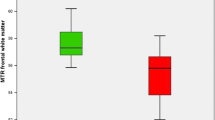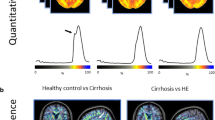Abstract
Cerebral blood flow (CBF), measured by the non-invasive 133-Xenon inhalation method, plasma levels of ammonia (NH3) and free tryptophan (fTRP) were determined in 30 cirrhotic patients without overt encephalopathy. Psychometric evaluation detected subclinical hepatic encephalopathy (SHE) in 20 of them, and was normal in the other 10. A significant CBF difference (p<0.05) was found between the SHE and the non-SHE patients.
fTRP levels were significantly (p<0.05) higher in patients with SHE than in those without SHE, and a significant negative correlation (p=0.003) was found between CBF values and fTRP in the whole group of patients. NH3 did not differ in the two subgroups and did not correlate with CBF values.
It is concluded that CBF could have some implications in SHE, although its relevance is still unclear. The negative correlation between CBF and fTRP prompts further investigation concerning the relationships between plasma fTRP, brain serotonin, cerebral metabolism and blood flow in the development of brain derangement during cirrhosis.
Sommario
Abbiamo determinato il Flusso Ematico Cerebrale (CBF), tramite la metodica inalatoria non invasiva allo Xenon-133, i livelli plasmatici di Ammonio (NH3) e del Triptofano libero (fTRP) in 30 pazienti cirrotici senza encefalopatia conclamata. La valutazione psicometrica rivelò un'Encefalopatia Epatica Subclinica (SHE) in 20 di loro, mentre negli altri 10 era nei limiti della norma.
Una differenza significativa (p<0.05) dei valori di CBF fu riscontrata tra i pazienti con SHE e quelli senza SHE.
I livelli di fTRP erano significativamente più elevati (p<0.05) nei pazienti con SHE rispetto a quelli senza SHE e una correlazione negative statisticamente significativa (p=0.003) fu trovata tra i valori di CBF e quelli di fTRP nell'intero gruppo dei pazienti. I livelli di NH3 non differivano nei due sottogruppi e non correlavano con i valori di CBF.
Si conclude che la SHE potrebbe avere un ruolo nella riduzione del CBF osservata in alcuni pazienti, anche se il suo ruolo preciso non è ancora chiarito. Ulteriori ricerche sono necessarie per chiarire le interazioni tra il CBF, il fTRP ed i sistemi neurotrasmettitoriali serotoninergici nella genesi della compromissione encefalica in corso di cirrosi epatica.
Similar content being viewed by others
References
Berglund M., Ingvar H.:Cerebral blood flow and its regional distribution in alcoholism and in Krosakoff's psychosis. J.S. Alc. 37:586–597, 1976.
Berglund M., Risberg J.:Regional cerebral blood flow during alcohol withdrawal. Arch. Gen. Psychiatry 38:351–355, 1981.
Bernhardi S., Trimble M.R., Franckowiak R.S.J., Wise R.J.S., Jones T.:An interictal study of partial epilepsy using positron emission tomography and the oxygen-15 inhalation technique. J. Neurol. Neurosurg. Psychiatry 46:473–477, 1983.
Bernthal P., Hays A.L., Tarter R.E., Sandford S.S., Van Thiel D.H.:Cerebral CT scan abnormalities in cholestatic and hepatocellular disease and their relationship to neuropsychologic test performance. Hepatology 7:105–114, 1987.
Blauenstein U.W., Halsey J.S., Wilson E.M., Wills E.:133-xenon method, analysis of reproducibility: some of its physiological implications. Stroke 8:92–102, 1977.
Bode J.C., Schafer K.:Pathophysiology of chronic hepatic encephalopathy. Hepato-gastroenterol 32:259–266, 1985.
Cascino A., Cangiano C., Fiaccadori F., Ghinelli F., Merli M., Pelosi G., Riggio O., Rossi-Fanelli F., Sacchini D., Stortoni M., Capocaccia L.:Plasma and cerebrospinal fluid aminoacid patterns in hepatic encephalopathy. Dig. Dis. Sci 27:828–832, 1982.
Christensen E., Schlichting P., Fuerholdt L., Gluud C., Andersen P.K., Juhl E., Poulsen H., Tygstrup N.:Prognostic value of Child-Turcotte criteria in medically treated cirrhosis. Hepatology 3:430–435, 1984.
Conn H.O.:Trailmaking and number-connection test in the assessment of mental state in portal systemic encephalopathy. Dig. Dis. 22:541–550, 1977,
Crossley I.R., Wardle E.N., William R.:Biochemical mechanism of hepatic encephalopathy. Cli. Sci. 64:247–252, 1983.
Douglas W.W.:Histamine and 5-htdroxytryptamine (serotonin) and their antagonist, in: A. Goodman Gilman, L.S. Goodman, T.W. Rall, F. Murad (eds). The pharmacological basis of therapeutics. New York: MacMillan 605–638, 1985.
Fazekas J.F., Ticktin H.E., Ehrmantraut W.R., Alman R.W.:Cerebral metabolism in hepatic insufficiency. Am. J. Med. 21:843–849, 1956.
Franckowiak R.S.J., Pozzilli C., Legg N.J., Du Boulay G.H., Marshall J., Lenzi G.L., Jones T.:Regional cerebral oxygen supply and utilisation in dementia: a clinical and physiological study with oxygen-15 and computed tomography. Brain 104:753–758, 1981.
Fraser C.L., Arieff A.I.:Hepatic encephalopathy. N. Engl. J. Med. 313:865–873, 1985.
Gibbs J.M., Wise R.S.J., Leenders K.L., Jones T.:The relationship of regional cerebral blood flow, blood volume, and oxygen metabolism in patients with carotid occlusion: evaluation of perfusion reserve.J. Cereb. Blood Flow 3, S590, 1983.
Gibbs J.M., Frackowiak R.S.J., Wise R.J.S., Lammerrtsma A.A., Rhodes C.G., Jones T.:The current State of rCBF, rCMRO2, rCBV, and rCMRGlu studies at the Hammersmith Hospital. In: Cerebral Blood Flow and Metabolism Measurement (A Hartmann and S Hoyer Eds.) Springer-Verlag, 419–429, 1985.
Gitlin N.:Subclinical portal systemic encephalopathy. Am. J. Gastroenterol. 83:8–11, 1988.
Grifftth S.G., Lincoln J., Burnstock G.:Serotonin as a neurotransmitter in cerebral arteries. Brain Research 247:388–392, 1982.
Guilbault G.G., Froehlich P.M.:Rapid, sensitive and selective assay for tryptophan in serum. Clin. Chem. 19:1112–1113, 1973.
Hata T., Meyer J.S., Tanahashi N., Iishikawa Y., Imai A., Shinohara T., Velez M., Fann W.E., Kandula P., Sakai F.:Three-dimensional mapping of local cerebral perfusion in alcoholic encephalopathy with and without Wernicke-Korsakoff syndrome. J. Cereb. Blood Flow Metab. 7:35–44, 1987.
Heiss W.D., Kufferle B., Demel I., Reisner T., Roszuczky A.:Cerebral blood flow and severity of mental dysfunction in chronic alcoholism. In: Cerebral Vascular Disease (Seventh international Salzburg Conference, 1974) Meyer J.S., Lechner H., Reivich M. (eds) Stuttgart, Georg Thieme, 89–93, 1976.
Holm E., Striebel J.P., Kattermann R., Schick E., Staedt U.:Encephalopathy resulting from portacaval anastomosis in cats. Ammonia, amino acids, and cerebral electrical activity. In: Holm E. (ed.): Aminosauren- und Ammoniakstoffwechsel bei Leber-insuffiziens. Witzstrock, Baden-Baden, 58–94, 1982.
Houston D.S., Vanhoutte P.M.:Serotonin and the vascular system — Role in health and disease, and implications for therapy. Drugs 31:149–163, 1986.
Hoyumpa A.M. JrSchenker S.:Perspectives in hepatic encephalopathy. J. Lab. Clin. Med 100:477–487, 1982.
Ishikawa Y., Meyer J.S., Tanahashi N., Hata T., Velez M., Fann W.E., Knadula P., Mortel K.F., Rogers R.L.:Abstinence improves cerebral perfusion and brain volume in alcoholic neurotoxicity without Wernicke-Korsakoff syndrome. J. Cereb. Blood Flow Metab. 6:86–94, 1986.
James I.M., Nashat S., Sampson D., Williams H.S., Garassini M.:Effect of induced metabolic alkalosis in hepatic encephalopathy. Lancet II, 1106–1108, 1969.
James J.H., Jeppson B., Ziparo V., Fisher J.E.:Hyperammoniaemic plasma aminoacid imbalance, and blood-brain aminoacid transport: a unified theory of portal-systemic encephalopathy. Lancet II:772–775, 1979.
Jones E.A., Shafer D.R., Ferenci P., Pappas S.C.:The neurobiology of hepatic encephalopathy. Hepatology 4:1235–1242, 1984.
Kruger G., Hoyer S.:Brain blood flow and metabolism related to psychiatric syndromes in alcoholism. Acta Neurol Scand 72: Suppl. 60, 570–571, 1979.
Lehrl S., Merz J., Erzigkeit H., Galster V.:Der MWT-A ein wieder holbarer intelligenz Kurtz-test. Nervenartz 45:364–369, 1974.
Mans A.M., Biebuyck J.F., Saunders S.J., Kirsch R.E., Hawkins R.A.:Tryptophan transport across blood-brain barrier during acute hepatic failure. Neurochemistry 33:409–418, 1979.
Morgan, M.G., Jakobovits A.W., James I.M., Sherlock S.:Successful Use of Bromocriptine in the treatment of chronic hepatic encephalopathy. Gastroenterology 78:663–670, 1980.
Munro H.N., Fernstrom J.D., Wurtman R.J.:Plasma aminoacid imbalance and hepatic coma. In: Ahnefeld F.W., Bergmann H., Burri C., Dick W., Halmagyi M., Rugheimer E.: Klinische Anasthesiologie und Internsivtherapie. Bd. XIII, Springer, Heidelberg, 103–112, 1977.
Obrist W.D., Thompson H.K., Kin C.H., Wang H.S.:Determination of regional cerebral blood flow by inhalation of 133 Xenon. Circ. Res. 20:124–135, 1967.
Obrist W.D., Thompons H.K., Wang H.S., Wilkinsons W.E.:Regional Cerebral Blood Flow estimated by 133-Xenon inhalation. Stroke 6:245–256, 1975.
Ono J., Hutson D.G., Dombro R.S., Levi J.U., Livingstone A., Zeppa R.:Tryptophan and hepatic coma. Gastroenterology 74:196–200, 1978.
Posner J.B., Plum F.:The toxic effects of carbon dioxide and acetazolamide in hepatic encephalopathy. J. Clin. Invest 39:1246–1258, 1960.
Qureshi M.Y., Smith S.M., Murphy G.M.:colorimetric enzymatic measurement of serum total 3-hydroxy bile acid concentrations without extraction. J. Clin. Pathol. 37:317–320, 1984.
Raichle M.E., Grubb R.B., Gado M.H., Eichling J.O., Ter-Pogossian M.M.:Correlation between regional cerebral blood flow and oxidative metabolism. Arch. Neurol. 33:523–526, 1976.
Risberg J., Ali Z., Wilson E.M., Wills E.L., Halsey J.H.:Regional cerebral blood flow by 133 Xenon inhalation. Preliminary evaluation of a initial slope index in patients with unstable flow compartments. Stroke 6:142–148, 1975.
Rodriguez G., Testa R., Rosadini R., Arvigo F., Celle G., Gris A., Sannita W.G., Sukkar G.S., Traverso R.:Reduction of regional cerebral blood flow in subclinical hepatic encephalopathy. IRCS Medical Science 11:1983, 1983.
Rodriguez G., Testa R, Celle G., Gris A. Marenco S., Nobili F., Novellone G., Rosadini G.:Reduction of cerebral blood flow in subclinical hepatic encephalopathy and its correlation with plasmafree Tryptophan. J. Cereb. Blood Flow Metab. 7:768–772, 1987.
Sherlock S.:Disease of the liver and biliary system. 7rd ed. Oxford-Blackwell Scientific Publications, 1985.
Shomerus H., Hamster W., Blunck H., Reinhard U., Mayer K., Dolle W.:Latent portasystemic encephalopathy. Nature of cerebral functional defects and their effect on fitness to drive. Dig. Dis. Sci 26:622–630, 1981.
Tarter R.E., Hays A.L., Sandford S.S., Van Thiel D.H.:Cerebral morphological abnormalities associated with non-alcoholic cirrhosis. Lancet 2:893–895, 1986.
Yoshida K., Hirayama C.:Clinical evaluation of serum leve of tryptophan in hepatobiliary disease. Clin. Chim. Acta 101:235–240, 1980.
Woolley D.W.:The biochemical bases of psychoses or the serotonin hypothesis about mental illness. John Wiley & sons, Inc., New York, 1962.
Zeneroli M.L., Cioni G., Vezzelli C., Grandi S., Crisi G., Luzietti R., Ventura E.:Prevalence of brain atrophy in liver cirrhosis patients with chronic persistent encephalopathy. J. Hepatol 4:283–292, 1987.
Author information
Authors and Affiliations
Rights and permissions
About this article
Cite this article
Testa, R., Rodriguez, G., Arvigo, F. et al. Cerebral blood flow and plasma free tryptophan in cirrhotics with and without hepatic encephalopathy. Ital J Neuro Sci 10, 415–421 (1989). https://doi.org/10.1007/BF02334946
Issue Date:
DOI: https://doi.org/10.1007/BF02334946




